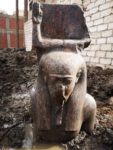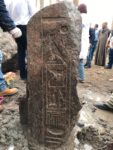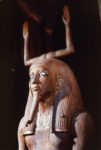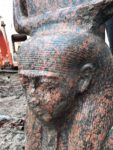 A unique statue of Ramesses II adorned with the “ka” sign has been discovered. The ka was the life-force of an individual, the key spirit of a person that continued the live after physical death. It was the ka, entombed with the body it once inhabited, which ate the food offerings and dwelled in the ka statue to keep itself (and therefore the deceased) eternally alive. The only other ka statue of a pharaoh that has been found is the life-sized wooden statue of the 13th Dynasty pharaoh Hor (ca. 1750 B.C.), discovered in the pharaoh’s tomb in 1894 and considered an artistic masterpiece of the period.
A unique statue of Ramesses II adorned with the “ka” sign has been discovered. The ka was the life-force of an individual, the key spirit of a person that continued the live after physical death. It was the ka, entombed with the body it once inhabited, which ate the food offerings and dwelled in the ka statue to keep itself (and therefore the deceased) eternally alive. The only other ka statue of a pharaoh that has been found is the life-sized wooden statue of the 13th Dynasty pharaoh Hor (ca. 1750 B.C.), discovered in the pharaoh’s tomb in 1894 and considered an artistic masterpiece of the period.
The statue was found on private property in the town of Mit Rahina near the temple of the god Ptah in ancient Memphis. A 62-year-old man excavated under his house and came across large blocks of stone immersed in the ground water. Unauthorized excavation is illegal in Egypt due to the potential for damage to archaeological material and the risk of artifact trafficking. Police busted him earlier this month and Ministry of Antiquities archaeologists began a salvage excavation.
 The team unearthed the top half of a rose granite statue of 19th Dynasty pharaoh Ramesses II (r. 1279–1213 B.C.). The statue is 1’10” wide and just shy of 3’5″ high and depicts the pharaoh wearing a tripartite hair wig with the symbol for “ka” (two upraised arms connected in the middle forming a u-shape) over his head. On the back pillar is the hieroglyphic inscription “Ka Nakht Mari Maat,” literally “The Powerful Loved Bull Maat”. Ramesses’ regnal name was Usermaatre Setepenre, meaning “The Maat of Ra is powerful, Chosen of Ra.” (The Greek name for Ramesses, Ozymandias, of Shelley look-on-my-works-ye-mighty-and-despair fame, is derivation of Usermaatre.)
The team unearthed the top half of a rose granite statue of 19th Dynasty pharaoh Ramesses II (r. 1279–1213 B.C.). The statue is 1’10” wide and just shy of 3’5″ high and depicts the pharaoh wearing a tripartite hair wig with the symbol for “ka” (two upraised arms connected in the middle forming a u-shape) over his head. On the back pillar is the hieroglyphic inscription “Ka Nakht Mari Maat,” literally “The Powerful Loved Bull Maat”. Ramesses’ regnal name was Usermaatre Setepenre, meaning “The Maat of Ra is powerful, Chosen of Ra.” (The Greek name for Ramesses, Ozymandias, of Shelley look-on-my-works-ye-mighty-and-despair fame, is derivation of Usermaatre.)
 The blocks of stone were the remains of a temple to Ptah, patron deity of the ancient capital of Memphis. In addition to the statue, 19 blocks of rose granite and limestone engraved with dedications to Ptah, cartouches of Ramesses II and depictions of the pharaoh engaged in the Heb Sed ceremony, a ritual celebrated when a king had ruled for 30 years (and every three to four years after that, which would turn out to be a lot because his reign lasted 66 years). It’s likely the ka statue was connected
The blocks of stone were the remains of a temple to Ptah, patron deity of the ancient capital of Memphis. In addition to the statue, 19 blocks of rose granite and limestone engraved with dedications to Ptah, cartouches of Ramesses II and depictions of the pharaoh engaged in the Heb Sed ceremony, a ritual celebrated when a king had ruled for 30 years (and every three to four years after that, which would turn out to be a lot because his reign lasted 66 years). It’s likely the ka statue was connected  to the Heb Sed celebration of Ramesses the Great’s long and successful reign.
to the Heb Sed celebration of Ramesses the Great’s long and successful reign.
The remains found so far have been recovered and transferred to the Mit Rahina open air museum. There they will be conserved and stabilized while excavations continue.